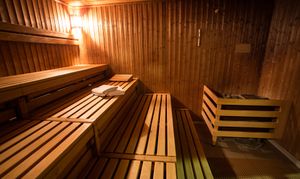Thermotherapy
Thermotherapy is the treatment of disease by the application of heat.[1]
Methods[edit | edit source]
Sauna[edit | edit source]
Traditional sauna[edit | edit source]

The Traditional sauna uses a heating element to increase the ambient air temperature. Sauna has been widely used in Finland for centuries. Today there are 2 million saunas in Finland, which has a population of 5 million.[2] During a short sauna the average person will lose a pint of sweat. Patients afflicted with asthma or psoriasis have reported symptom relief.[3]
Infrared sauna[edit | edit source]
An infrared sauna uses electrified ceramic plates to heat the skin. Far infrared radiation's effects include increasing artery blood flow, improving endothelial function, reduction in blood pressure and alleviating fatigue.[4] A small 2005 study observed symptomatic relief for chronic fatigue syndrome (CFS) patients from daily usage for 35 days.[5]
Hot bathing[edit | edit source]
Whirlpool or hot bath.
Heath effects[edit | edit source]
Immune system[edit | edit source]
Animal models of the effects of thermotherapy have returned a wide range of results. Hormesis in some species results in enhanced resistance to future infections. However, in other animal models it results in an enhancement of other physiological systems at the detriment of the immune system. Even the animals whose immune systems were weakened still had longer life expectancy.
Mitochondria[edit | edit source]
When the human body is activated by environmental stressors (e.g. heat or oxidative stress), it enters a state called hormesis. A 2008 study found that hormesis causes mitochondrial biogenesis.[6] Patients with ME/CFS have been show to have reduced mitochondrial function, so this is why thermotherapy or cryotherapy may be beneficial.
Longevity[edit | edit source]
Theromotherapy causes the activation of heat shock proteins. This mild acute stress results in the activation of cells protection mechanism (hormesis).[citation needed] Over times this hormetic strengthening results in a greater homeodynamic capacity. As humans age their homeodynamic space shrinks. Therefore, hormesis helps to counterbalance this key component of aging.[7]
In human disease[edit | edit source]
Sauna was found to be beneficial for antihistamine-resistant urticaria, an autoimmune disease.[8]
While exposure to heat (as well as cold) can tone the vagus nerve and is beneficial for the autonomic nervous system[citation needed] many patients with dysautonomia including patients with myalgic encephalomyelitis (ME) and postural orthostatic tachycardia (POTS) are intolerant to heat and cold.
A case study of two patients with CFS found dramatic improvement in self-reported fatigue, pain, sleep disturbance, and low-grade fever after daily sauna use for 35 days.[5]
See also[edit | edit source]
References[edit | edit source]
- ↑ "thermotherapy". The Free Dictionary.
- ↑ "PBS Steam of Life". PBS.
- ↑ "Saunas and your health". Harvard Health.
- ↑ Shui, Shanshan; Wang, Xia; Chiang, John Y; Zheng, Lei (October 2015). "Far-infrared therapy for cardiovascular, autoimmune, and other chronic health problems: A systematic review". Experimental Biology and Medicine. 240 (10): 1257–1265. doi:10.1177/1535370215573391. ISSN 1535-3702. PMC 4935255. PMID 25716016.
- ↑ 5.0 5.1 Masuda, Akinori (April 2005). "The effects of repeated thermal therapy for two patients with chronic fatigue syndrome". Journal of psychosomatic research. 58 (4): 383–387. PMID 15992574.
- ↑ Sano, Fukuda, Motoaki, Keiichi (November 2008). "Activation of Mitochondrial Biogenesis by Hormesis". Circulation Research. 103.
- ↑ Suresh, I.S. Rattan (January 2008). "Hormesis in aging". Ageing Research Reviews. 7 – via 63-78.
- ↑ Magen, Eli (March 2014). "Beneficial effect of sauna therapy on severe antihistamine-resistant chronic urticaria". The Israel Medical Association journal: IMAJ. 16 (3): 182–183. ISSN 1565-1088. PMID 24761711.

